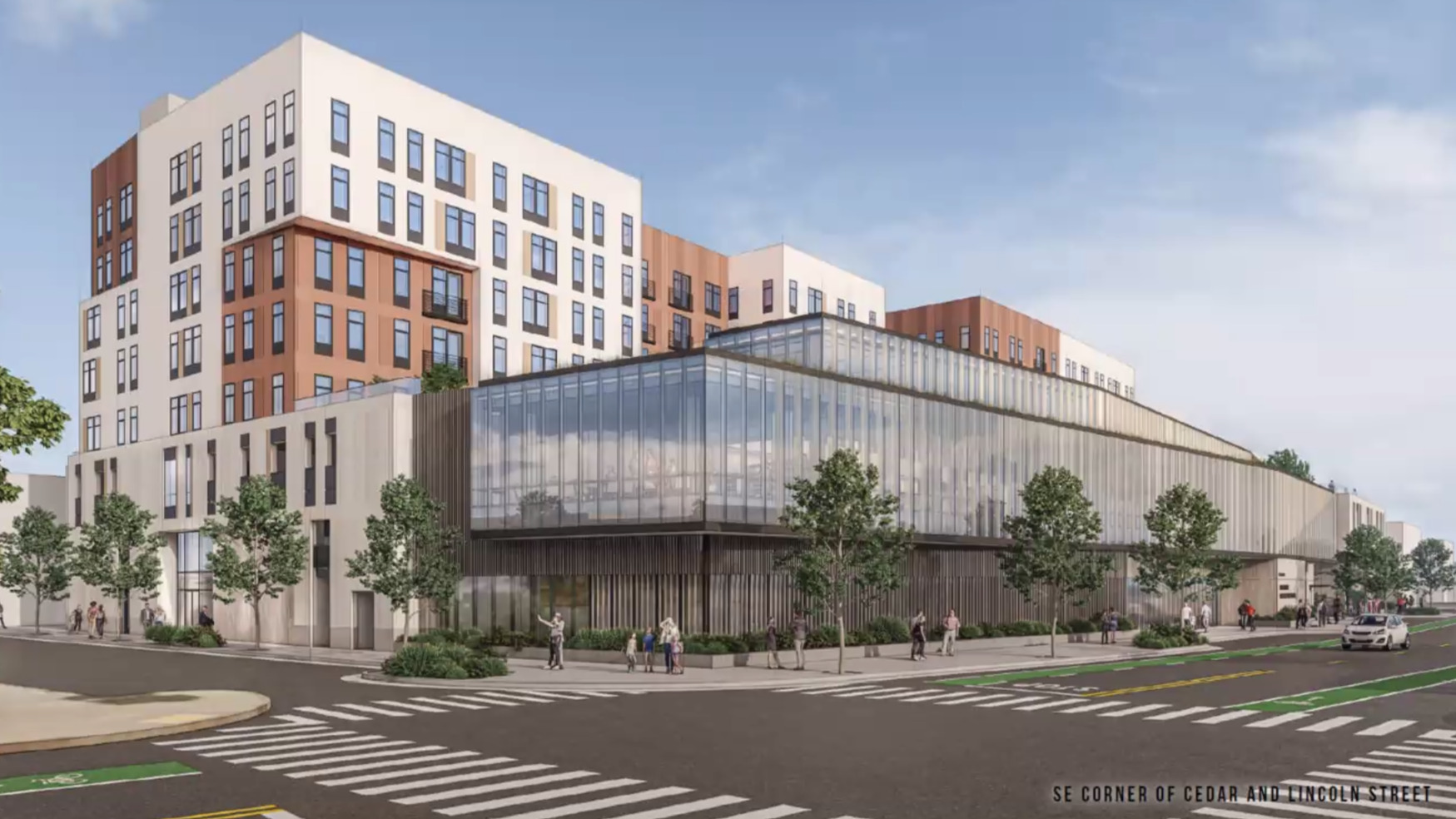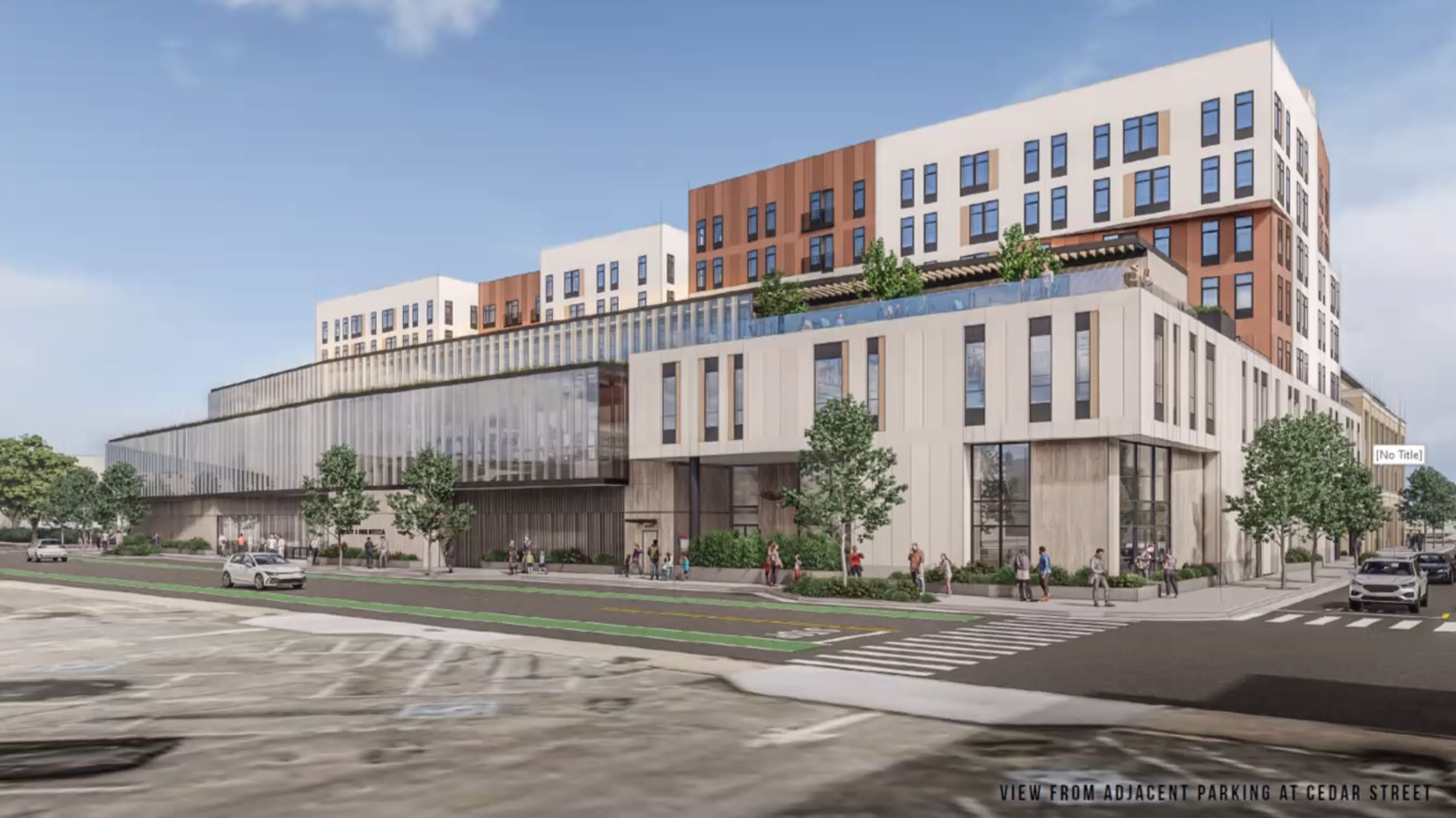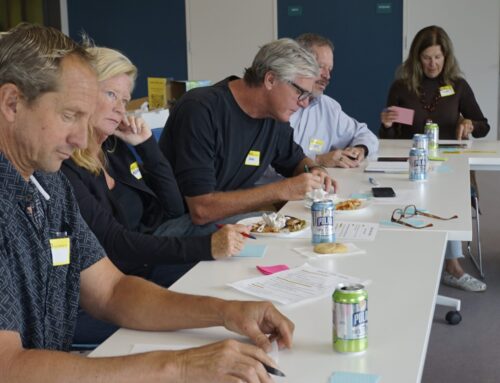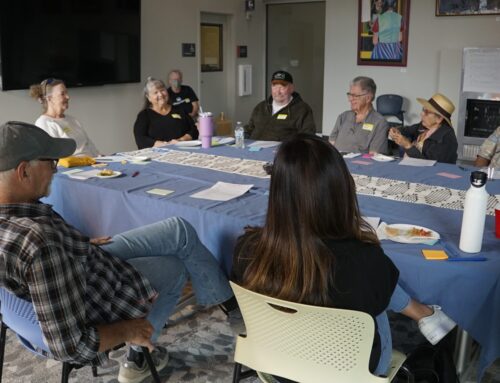
Santa Cruz city staff on Tuesday showed updated renderings of the Downtown library, housing and parking garage project. It would include 124 affordable housing units, a child care center and a commercial space. (Jayson Architecture)
SANTA CRUZ >> New details emerged Tuesday about the funding and proposed design of the Downtown Santa Cruz library, housing and parking garage project.
At a Santa Cruz City Council meeting Tuesday, Santa Cruz Economic Development Director Bonnie Lipscomb presented the most recent design plan. It includes:
- A 38,000-square-foot library with a 3,200 square-foot rooftop patio.
- A 1,900-square-foot child care center and play area.
- A 9,600-square-foot commercial space.
- A three-story, 243-space parking garage.
- Locked enclosures and racks for 258 bicycles.

A project at Cedar and Cathcart streets is expected to include a new library, housing, a parking garage, shops and a childcare center. (Jayson Architecture)
The affordable housing project will provide 124 units, including:
- 31 three-bedroom units.
- 31 two-bedroom units.
- 48 one-bedroom units.
- 13 studios.
Eighty units will be for renters designated as “very low income” who earn 50% or less of the area median income. The income limit for those units is about $54,000 to $78,000, depending on the household size. Rents would range from about $1,294 to $1,877 per month, city staff said.
Twenty-seven units will be allocated for “extremely low income” renters who earn 30% or less of the area median income. The income limit for those units is about $32,000 to $47,000, depending on the household size. Rents would range from about $749 to $1,068 per month, city staff said.
“Extremely low income” units are difficult to include in other kinds of affordable housing, such as inclusionary units in large developments, Lipscomb said. “We’re going lower because those are the most expensive units to build,” she said.
The 16 remaining units would be designated for renters who earn 60% or less of the area median income. The income limit for those units is about $65,000 to $93,000, depending on the household size. Rents would range from $1,566 to $2,281 per month, city staff said.
Garage and farmers market
The three-story parking lot with 243 spaces will cost an estimated $14.5 million, financed by parking district bonds or direct loans, Lipscomb said. The city will use the money earned by the parking garage, and the rest of the city’s parking district, to help repay the debt.
Councilmember Sandy Brown asked whether the parking district is in a financial position to finance the parking lot.
“As a whole, we do believe that we’re on solid ground when it comes to the parking district,” said City of Santa Cruz development manager Brian Borguno. “We’re kind of coming out of COVID and the revenues have rebounded.”
City staff are also working with the Santa Cruz Farmers Market to determine the future site of the weekly market.
- The farmers market uses city parking Lot 4, which is the site of the library project.
- In July, city staff submitted a draft memorandum of understanding to the board of the Santa Cruz Farmers Market to guide the future location and design of the market.
- The agreement includes a proposal for a new permanent location on city parking Lot 7 at the corner of Cathcart and Front streets. The new 40,000-square-foot location would have covered market space.
- The farmers market board will consider the agreement in October.
The library’s most recent budget estimate is $42.7 million, down $625,000 from the previous estimate. A slightly shorter first floor brought costs down slightly, Lipscomb said.
The affordable housing component of the project has secured $7.39 million to date. The money includes:
- $3.6 million from the Local Housing Trust Fund and $1.55 million from the Permanent Local Housing Allocation. Both are programs of the California Department of Housing and Community Development.
- $2 million in federal funding from a congressional earmark authored by U.S. Rep. Jimmy Panetta, D-Carmel.
- $240,000 grant from Central Coast Community Energy.
- The city was not awarded any money in the first round of funding for a state library grant, but may receive a grant in the second round, Lipscomb said.
Developers will be able to apply for the rest of the funding needed in January if the Santa Cruz City Council approves the final plans for the project in December. Those funds include $43 million in tax credits, $78 million in loans, and an undetermined amount in state and federal grants, Lipscomb said. Construction is slated for May 2024 to May 2026.
But that timeline could stop if voter initiative Measure O passes in November. The measure would require the city to renovate the existing library, rather than construct a new mixed-use building. It would also designate Lot 4 as the permanent home for the farmers market.
Council approves water connection with Scotts Valley
The Santa Cruz City Council on Tuesday approved a project to create an emergency connection between the city’s water supply and Scotts Valley Water District.
The intertie will:
- Allow the districts to share water in case of wildfire.
- Enable Scotts Valley to use water from the San Lorenzo River when flows are high.
- Allow the districts to pursue projects that would use City of Santa Cruz Water District water to replenish Scotts Valley Water District’s groundwater.
Plans for an intertie between the two systems have been in the works since 2012. Design work was abandoned in 2013 because of lack of funding, according to a city staff report. In March, the California Department of Water Resources awarded Scotts Valley Water District $9.4 million to complete the intertie.
Water sharing has been part of a regional push for drought resiliency. In 2016, the San Lorenzo Valley Water District completed an intertie with Scotts Valley Water District. The City of Santa Cruz has proposed updated water rights rules that would allow the city to share water with surrounding districts. Those rules await approval from the State Water Control Board.
The project includes:
- A new pump station capable of pumping water between San Lorenzo Valley Water District and the City of Santa Cruz.
- About 9,100 feet of pipeline along La Madrona Drive and Sims Road to connect the Pasatiempo tank to the new pump station.
- About 140 feet of pipeline connecting the new pump station to a San Lorenzo Water District’s system.
The council unanimously approved the project as part of the consent agenda.
Council explores potential cigarette ban
The Santa Cruz City Council on Tuesday directed its Health in All Policies Committee to study the possibility of banning single-use tobacco products.
The direction comes after activists urged the council in May to ban cigarette filters to prevent coastal pollution. Cigarette butts make up about a third of all pollution in California, according to the California Department of Public Health.
Tara Leonard, health educator for the County of Santa Cruz, compared a potential ban on tobacco products to the city’s ban on flavored nicotine. The City of Santa Cruz was the first jurisdiction in the county to enact a ban on flavored nicotine. The other cities in the county have followed suit. “Somebody has to be first,” she said.
Leonard presented several possible policies the city could adopt:
- Ban the sale of single-use cigarette filters.
- Ban the sale of single-use e-cigarettes or all e-cigarettes.
- Ban the sale of other tobacco products that produce waste, including lighters and cigar tips.
- Require hazardous waste tracking for nicotine products.
- Limit the density of nicotine retailers.
Nine stores in the city earn more than 50% of revenue from the sale of tobacco products, Leonard said.
Several residents who attended Tuesday’s meeting urged the council to focus policies on single-use cigarette butts.
Alli Webster, chair of the Surfrider Foundation Santa Cruz chapter, held up a jar filled with butts collected from the beach on a walk. “Anyone would be horrified at the idea of dumping this jar right into the ocean. And yet we walked by hundreds of butts on the ground every day,” Webster said.
The council voted unanimously to direct the Health in all Policies Committee to return to the city council with recommendations by February and to join the state workgroup addressing the economic model associated with tobacco waste.
The Health in All Policies Committee comprises Mayor Sonja Brunner, Vice Mayor Martine Watkins and Councilmember Shebreh Kalantari-Johnson.
Editor’s note: This story has been updated to correct the number of affordable housing units in the proposed Downtown Library, garage and housing project.
Questions or comments? Email [email protected]. Learn more about Santa Cruz Local and how we are funded. Santa Cruz Local is supported by members, major donors, sponsors and grants for the general support of our newsroom. Our news judgments are made independently and not on the basis of donor support.
Santa Cruz Local’s news is free. We believe that high-quality local news is crucial to democracy. We depend on locals like you to make a meaningful contribution so everyone can access our news. Learn about membership.
Jesse Kathan is a staff reporter for Santa Cruz Local through the California Local News Fellowship. They hold a master's degree in science communications from UC Santa Cruz.





